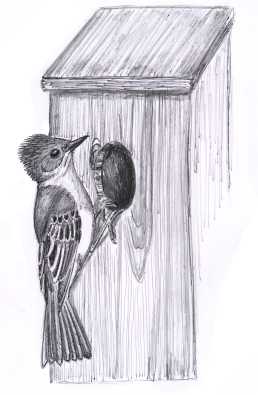
Dear Bird Folks,
Over the winter, some creature enlarged the opening of my bluebird nest box and before I got around to fixing it, an unusual bird moved in. I’ve never seen this bird before. It is a noisy bird with a long, rusty tail. Any guesses what it is?
– Carol, East Orleans
Yes, Carol,
Of course I’ve got a guess. My guess is you have a Great Crested Flycatcher moving into your nest box. Great Crested Flycatchers are yet another one of those common birds that live around here, that most people don’t know about. Great Crested Flycatchers (GCF’s as they are known to their friends) are, indeed, fly catchers. They earn their living by sitting on an exposed branch and waiting for a fly, or other juicy insect, to come along. As soon as they spot a meal, which includes houseflies, butterflies, dragonflies or anything else that has the word fly in it, they dart out to pick off the unsuspecting insect. The flycatcher returns to its branch, chows down its fly de jour and then sits back to wait for another meal to fly past. For those of you who have insect issues, the GCF is a very beneficial bird.
What makes this flycatcher different from out other flycatchers (and we do have others) is that it is a secondary cavity nester. Being a secondary cavity nester does not mean this bird has a second home in Hilton Head or Fort Lauderdale. It means they don’t dig out their own cavities. The Great Crested Flycatcher depends on old woodpecker holes or birdhouses to build its nest in.
The GCF would readily come to our nest boxes, but most of our boxes are geared for bluebirds and bluebird boxes are a bit too small for a Great Crested Flycatcher. Perhaps that is why it was attracted to your recently enlarged nest box. In addition to nest boxes, the GCF has been known to build its nest in some odd places including rural route mail boxes. However, in recent years, the habit of nesting in mail boxes has declined, probably due to the constant increases in postage rates. Just like you said, Carol, GCF’s have long rusty tails and also a yellow underside. But the “great crest” on their heads is a bit of a disappointment. These birds look more like they have a bad case of bed head than a great crest.
They also hve a rather unique call that more often is heard than the bird is seen. The GCF has a loud, excited “wheep” call that can be heard throughout its territory. It is thought that this excited “wheep” call probably started when a startled bird first saw its bad looking crest in the bathroom mirror
After your flycatchers have finished nesting, be sure to clean out the nest box right away, for you may find a surprise. Over half of all GCF nests have an old snakeskin in them. Honest! As most of you know, snakes shed their skin as they grow. Somehow the GCF finds this cast off skin and adds it to its nest. Why the birds do this is anybody’s guess. Some authorities speculate that the snakeskin is used to scare away predators. However, it is doubtful that many predators have any serious phobias related to dried skin – dried prunes perhaps, but not dried skin.
If they can’t locate any snakeskin, the GCF will often pick up similar items like cellophane, plastic or waxed paper. So when you open up your nest box, Carol, it would be normal to find either bits of plastic or some dried snakeskin. However, if you find your nest box full of dried prunes, I don’t want to know about it.